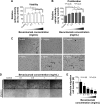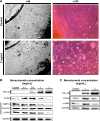Effects of anti-vascular endothelial growth factor monoclonal antibody (bevacizumab) on lens epithelial cells
- PMID: 27418802
- PMCID: PMC4935105
- DOI: 10.2147/OPTH.S103443
Effects of anti-vascular endothelial growth factor monoclonal antibody (bevacizumab) on lens epithelial cells
Abstract
The molecular and cellular effects of anti-vascular endothelial growth factor monoclonal antibody (bevacizumab) on lens epithelial cells (LECs) were examined using both an immortalized human lens epithelial cell line and a porcine capsular bag model. After treatment with various concentrations of bevacizumab, cell viability and proliferation patterns were evaluated using the water-soluble tetrazolium salt assay and 5-bromo-2'-deoxyuridine enzyme-linked immunosorbent assay, respectively. The scratch assay and Western blot analysis were employed to validate the cell migration pattern and altered expression levels of signaling molecules related to the epithelial-mesenchymal transition (EMT). Application of bevacizumab induced a range of altered cellular events in a concentration-dependent manner. A 0.1-2 mg/mL concentration demonstrated dose-dependent increase in proliferation and viability of LECs. However, 4 mg/mL decreased cell proliferation and viability. Cell migrations displayed dose-dependent retardation from 0.1 mg/mL bevacizumab treatment. Transforming growth factor-β2 expression was markedly increased in a dose-dependent manner, and α-smooth muscle actin, matrix metalloproteinase-9, and vimentin expression levels showed dose-dependent changes in a B3 cell line. Microscopic observation of porcine capsular bag revealed changes in cellular morphology and a decline in cell density compared to the control after 2 mg/mL treatment. The central aspect of posterior capsule showed delayed confluence, and the factors related to EMT revealed similar expression patterns to those identified in the cell line. Based on these results, bevacizumab modulates the proliferation and viability of LECs and induces morphological alterations through the modulation of expression patterns of specific factors related to the EMT.
Keywords: avastin; bevacizumab; lens epithelial cell; transforming growth factor; vascular endothelial growth factor.
Figures



Similar articles
-
LncRNA HOTAIR mediates TGF-β2-induced cell growth and epithelial-mesenchymal transition in human lens epithelial cells.Acta Biochim Biophys Sin (Shanghai). 2018 Oct 1;50(10):1028-1037. doi: 10.1093/abbs/gmy101. Acta Biochim Biophys Sin (Shanghai). 2018. PMID: 30239553
-
Bit1-a potential positive regulator of epithelial-mesenchymal transition in lens epithelial cells.Graefes Arch Clin Exp Ophthalmol. 2016 Jul;254(7):1311-8. doi: 10.1007/s00417-016-3357-3. Epub 2016 Apr 28. Graefes Arch Clin Exp Ophthalmol. 2016. PMID: 27122244
-
CtBP2 Regulates TGFβ2-Induced Epithelial-Mesenchymal Transition Through Notch Signaling Pathway in Lens Epithelial Cells.Curr Eye Res. 2016 Aug;41(8):1057-1063. doi: 10.3109/02713683.2015.1092554. Epub 2015 Dec 17. Curr Eye Res. 2016. PMID: 26681554
-
Transforming growth factor-beta-induced epithelial-mesenchymal transition in the lens: a model for cataract formation.Cells Tissues Organs. 2005;179(1-2):43-55. doi: 10.1159/000084508. Cells Tissues Organs. 2005. PMID: 15942192 Review.
-
Roles of TGF β and FGF Signals in the Lens: Tropomyosin Regulation for Posterior Capsule Opacity.Int J Mol Sci. 2018 Oct 9;19(10):3093. doi: 10.3390/ijms19103093. Int J Mol Sci. 2018. PMID: 30304871 Free PMC article. Review.
Cited by
-
Therapeutic candidates for keloid scars identified by qualitative review of scratch assay research for wound healing.PLoS One. 2021 Jun 18;16(6):e0253669. doi: 10.1371/journal.pone.0253669. eCollection 2021. PLoS One. 2021. PMID: 34143844 Free PMC article. Review.
-
Incidence of Posterior Capsule Rupture During Phacoemulsification Cataract Surgery Among Patients Treated With Intravitreal Bevacizumab Injections.Cureus. 2024 Sep 26;16(9):e70297. doi: 10.7759/cureus.70297. eCollection 2024 Sep. Cureus. 2024. PMID: 39469352 Free PMC article.
-
[Lens injury as a complication of intravitreal medication injection].Ophthalmologie. 2024 May;121(5):385-390. doi: 10.1007/s00347-024-01997-8. Epub 2024 Feb 16. Ophthalmologie. 2024. PMID: 38363379 German.
-
Effects of vascular formation during alveolar bone process morphogenesis in mice.Histochem Cell Biol. 2017 Oct;148(4):435-443. doi: 10.1007/s00418-017-1584-2. Epub 2017 Jun 13. Histochem Cell Biol. 2017. PMID: 28612087
References
-
- Shui YB, Wang X, Hu JS, et al. Vascular endothelial growth factor expression and signaling in the lens. Invest Ophthalmol Vis Sci. 2003;44(9):3911–3919. - PubMed
LinkOut - more resources
Full Text Sources
Other Literature Sources

